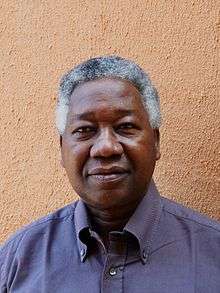Gaston Kaboré

Gaston Kaboré (born 1951) is a Burkinabé film director and an important figure in Burkina Faso's film industry.[1] He has won awards for his films Wend Kuuni and Buud Yam.
Biography
Kaboré was born in 1951 in Bobo-Dioulasso in Upper Volta.[2]
He studied history at the Sorbonne in Paris, France, receiving his license and Maîtrise (Master's) degrees.[2] While researching the history of racial prejudice against Africa by its colonisers for his Maîtrise, Kaboré was drawn to contemporary documentary films which, he felt, continued to propagate such stereotypes.[2] To better understand the "language of cinema", he decided to go to ESEC film school. Originally intending to use film as a medium for disseminating historical knowledge, he gradually grew passionate about film for its own sake. He received his degree in Film Production in 1976.[2] He returned to his native country to be director of the Centre National du Cinéma. His film Wend Kuuni was only the second feature film produced in Burkina Faso.[1] His work for the screen, focusing on his country’s rural heritage, has received numerous international awards, including a French César award.
In 1997 he won the first prize at the 15th Panafrican Film and Television Festival of Ouagadougou (FESPACO) with the film Buud Yam.[2]
From 1985 to 1997 he was the Secretary-General of the Pan African Federation of Filmmakers (FEPACI).[3] Since 2005 he has had a training school, Imagine, in Ouagadougou that trains professionals in the television and cinema industries.[1][3]
Filmography
- Wend Kuuni (1983)
- Zan Boko (1988)
- Rabi (1992)
- Lumière and Company (1995)
- Buud Yam (1997)
Notes
- 1 2 3 "Burkina Faso gets new film school". BBC. 2005-03-01. Retrieved 2008-02-11.
- 1 2 3 4 5 Eke, Maureen N.; Kenneth W. Harrow; Emmanuel Yewah (2000). African Images: Recent Studies and Text in Cinema. Trenton, New Jersey: Africa World Press. pp. 31–39. ISBN 0-86543-819-6. OCLC 43083199.
- 1 2 "Interview with...Gaston Kaboré". UNESCO. Retrieved 2008-02-11.
Further reading
Books
- Ukadike, Nwachukwu Frank (2002). Gaston Kaboré. Questioning African Cinema: Conversations with Filmmakers. Minneapolis, MN: University of Minnesota Press. pp. 109-120. ISBN 0-8166-4005-X.
External links
| Wikimedia Commons has media related to Gaston Kaboré. |